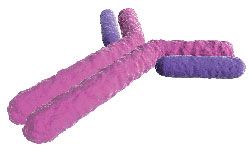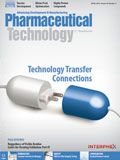Conjugation Chemistry with Highly Potent Compounds
Manufacturing highly toxic compounds in a biopharmaceutical environment tests equipment and systems.
Ingram Publishing/Getty Images

The global market for highly potent active pharmaceutical ingredients (HPAPIs) has been growing rapidly in recent years due to the rising prevalence of cancer, diabetes, and cardiovascular diseases, among others. The overall market was valued at $12.6 billion in 2014 and expanding at an estimated compound annual growth rate of 7.8% from 2015 to 2023, to reach $25.1 billion by 2023, according to Transparency Market Research (1).
The main driver of HPAPI market growth is the development of novel, targeted therapies, particularly antibody-drug conjugates (ADCs), which enable treatment with highly potent compounds that, if delivered systemically, would cause significant damage to healthy cells and tissues. ADCs consist of an antibody linked to a highly potent small-molecule “payload” that is released only once the antibody binds to the targeted cell.
Two ADCs have been approved by FDA: Adcetris (brentuximab vedotin from Seattle Genetics) and Kadcyla (ado-trastuzumab emtansine from Genentech). Approximately 40 additional ADCs were in various phases of clinical development as of early 2015 (2).
The production of ADCs requires expertise in both biopharmaceutical and chemical manufacturing, as well as the ability to conjugate highly potent small-molecule APIs to biologic components. This last step can be particularly challenging, given that it involves the manufacture of highly toxic compounds in a biopharmaceutical environment, according to Laurent Ducry, group leader, R&D bioconjugates with Lonza.
Conjugation chemistries
A number of different linker chemistries have been explored to connect the highly potent small-molecule drug to the antibody. The linker chemistry determines the release profile of the payload, and thus is crucial to the safety and efficacy of ADCs. The complete ADC must be stable during storage and throughout the time during which the antibody circulates in the bloodstream so that the drug is only released once the antibody binds to the target cell.
The types of conjugation chemistry that can be used are largely determined by the available functional groups that are present on the surface of the antibody and sufficiently distant from the binding site so as not to interfere with the function of the antibody. Most commonly, cysteines and lysines have been reacted with hydrazones, disulfides, peptides, and thioethers. Of the ADCs in development, more than half link to the thiol groups of cysteine residues, and at least a quarter are conjugated through surface lysines (2). The locations and quantities of cysteine and lysine residues vary from one antibody molecule to another, however, resulting in heterogeneous conjugation.
Several new conjugation technologies for site-selective reactions that result in homogeneous conjugation for ADC production are emerging to address this issue, according to Ducry. “These techniques have the potential to provide ADCs with improved therapeutic properties,” he notes.
Compared to traditional lysine and cysteine conjugation chemistries that produce a heterogeneous mixture of products, these novel conjugation techniques based on engineered antibodies or enzymatic reactions result in site-directed conjugation.
Some examples include selective N-terminal conjugation based on the differences in the reactivity of internal and terminal amino acids; site-specific functionalization of glutamines through selective enzymatic conjugation of specific residues; and protein engineering to incorporate at specific sites within the antibody unnatural amino acids with reactive moieties other than thiol or amine groups, such as aldehydes, ketones, azides, or alkynes (2). These new approaches are enabling the use of new conjugation chemistries, such as click reactions and enzymatic ligation (3).
Maintaining the right balance
The design of antibody-drug conjugates, which makes them effective, targeted therapies, also makes them challenging to produce. Expertise in bioprocessing (cell-culture and/or fermentation), chemical synthesis, linker technologies, and conjugation chemistry are all necessary, as is the ability to perform much of the manufacturing process under high-containment conditions due to the high potency of the small-molecule payload.
Different technologies and plant set-ups are required to synthesize, purify, and isolate small-molecule HPAPIs and biological targeting agents such as monoclonal antibodies. The bioconjugation step, which takes place in mostly aqueous media under aseptic conditions, requires a third set of production capabilities, according to Ducry.
In addition, while the conjugation of biologic compounds to non-potent chemical APIs is used for the manufacture of a number of different drug products, conjugation of highly potent APIs is a relatively new technology. “One of the key challenges for ADC manufacturing is addressing the need for high containment when working in a biopharmaceutical environment,” Ducry states. He adds that robust safety processes that ensure occupational safety but also enable effective cGMP manufacturing are required to address these challenges.
In biomanufacturing, it is important to prevent contamination of the large-molecule API by biologic material originating from operators or the environment. As a result, a cleanroom environment with positive pressure is used. When working with small-molecule HPAPIs, however, protecting operators and the environment from exposure to the API is the main concern. Specialized containment, handling, and personnel protective equipment, highly complex operating procedures, and the use of negative air pressure are employed to ensure a high level of safety.
The needs for bioconjugation of HPAPIs are therefore complex, because conflicting measures (positive and negative air pressure) are typically taken to prevent contamination and protect operators. Developing manufacturing conditions that ensure both operator safety and product purity is challenging. “Very few contract manufacturers have the unique set of capabilities necessary to achieve the balanced approach required for facilitating bioconjugation with HPAPIs,” observes Ducry.
Other challenges when performing conjugations with antibodies and highly potent payloads include the need for rigorous equipment cleaning and waste management. Cleaning to necessary levels can be difficult because cleaning limits are calculated based on the toxicity of the material. The cleaning limits for the ADC as well as the small-molecule API component are often quite low as a result, according to Ducry.
Waste treatment is also complicated by the presence of highly potent compounds. Again, protection of workers, the public, and the environment are the prime concern. Lonza has addressed this issue by incinerating all toxic waste on site at its Visp, Switzerland facility where toxin synthesis and conjugation are performed. “This solution provides optimal control, improved safety, and higher flexibility,” Ducry says.
Smaller scaffolds for the future
“Full-length antibodies remain the primary targeting agent used to selectively deliver cytotoxic agents to cancer cells because they have long circulation times,” Ducry says. He also notes that this approach has been validated by approved drugs such as Adcetris and Kadcyla, both of which Lonza manufactures.
Nonetheless, smaller scaffolds such as antibody fragments, bispecific antibodies, proteins, and synthetic peptides are being explored with the goal of improving penetration rates into tumors. Additionally, conjugated polymers and nanoparticles are emerging as new drug candidates, according to Ducry. “Based on the R&D activity occurring at many pharmaceutical/biopharmaceutical companies, we expect that the number of APIs being developed with targeted drug-delivery mechanisms will continue to grow.”
Simplification with single-use
The challenges posed by cleaning permanent stainless-steel equipment and managing the toxic waste generated in these processes can be minimized through the implementation of single-use technologies. “Use of disposable systems eliminates equipment cleaning and the need to develop sensitive analytical assays. The change-over time is shorter, and compared to dedicated equipment, there are no storage or start-up costs,” Ducry explains. He does add, however, that single-use equipment lacks the robustness of stainless steel, and therefore appropriate risk-management strategies must be employed to ensure that the necessary level of containment can be maintained.
Lonza began manufacturing ADCs in fully disposable systems in 2015 in order to simplify change over and cleaning processes, and has focused on managing the safety risk associated with highly potent cytotoxic compounds in accordance with its safety program. To date, the company has successfully produced five of its ADC products in fully disposable systems without any safety issues, according to Ducry.
References
1. Transparency Market Research, “Global High Potency Active Pharmaceutical Ingredients Market: Growing Demand for Targeted Therapeutics to Boost Market Growth at 7.8% CAGR,” Jan. 6, 2016,
2. N. Jain, S.W. Smith, S. Ghone, and B. Tomczuk, Pharm Res. 32(11), 3526-40 (2015).
3. J.S. McCombs and S.C. Owen, AAPS J. 17(2), 339-51 (2015).
Article DetailsPharmaceutical Technology
Vol. 40, No. 4
Pages: 34-37
Citation
When referring to this article, please cite it as C. Challener, “Conjugation Chemistry with Highly Potent Compounds," Pharmaceutical Technology 40 (4) 2016.

Drug Solutions Podcast: A Closer Look at mRNA in Oncology and Vaccines
April 30th 2024In this episode fo the Drug Solutions Podcast, etherna’s vice-president of Technology and Innovation, Stefaan De Koker, discusses the merits and challenges of using mRNA as the foundation for therapeutics in oncology as well as for vaccines.